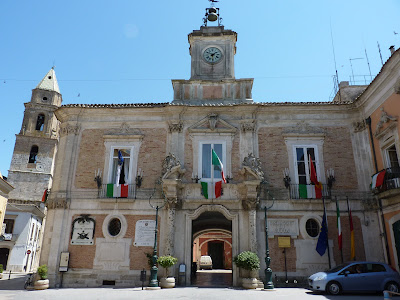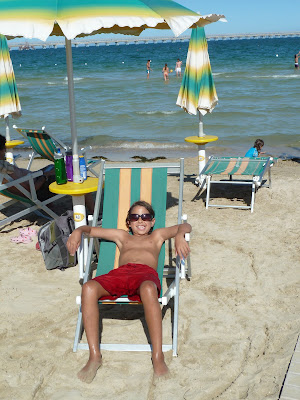Puglia, also known as Apulia (or "The Puggles" if you're punch-drunk from too many hours of driving with your family on the Italian Autostrada), is a long and thin region that forms the "heel" of the Italian "boot." After spending a week in the rolling green hills of Tuscany and Umbria, it is quickly apparent upon arriving in Puglia that you are in a different world. The landscape is different (hotter and drier), the architecture is different (with influences reminiscent of Spain, Greece and the Balkans), the economy is different (more agriculture, less industry), the world-view is different (more religious and traditional) - the whole vibe is different (think slow to the point of languid).
We started on the Gargano Peninsula, the "spur" of the boot and the northernmost part of Puglia. We arrived at lunchtime in the searing heat in the town of San Severo and as we walked the empty streets we were beginning to doubt whether anything would be open. We're in southern Italy now, where siesta time really matters. A local man offered to help by calling a couple of restaurants on his cell phone. The first one he tried was closed, but the second one - while not technically open - was hosting a private luncheon and agreed to feed us. There was no menu; the only choice was the set lunch the private party was having. The meal was a revelation. It was remarkably simple, but the flavors exploded off the plate. Fresh tomato bruschetta, a stunning array of vegetarian antipasti, a plate of sliced meats and cheeses, orecchiette with a perfectly balanced tomato sauce, homemade sausage, and some of the best bread we'd had on the entire yearlong trip. After our leisurely meal, we chatted with the friendly owner, who made detailed recommendations on the best places to see in Puglia.

One of these places is Monte Sant'Angelo, a compact little hilltown of stone and whitewash devoted to the archangel St. Michael, who according to Christian legend appeared in the town in the 5th and 17th centuries. (He ate a lot of yogurt and exercised regularly.) A funny thing struck me as we parked our rental car on the edge of town. In France and northern Italy, you typically pay for parking by putting coins in a machine that gives you a printed receipt; in some places there was no machine but there was someone in uniform to give you a receipt. Here, there were no machines, uniforms or receipts - just a bunch of scrappy looking guys "asking" for money from each car as it entered the lot. We gladly payed the two Euros as we noticed that some other tourists in a fancier car were forced to pay five Euros by a different "attendant." Somehow, I got the feeling the town wasn't receiving any of the parking revenues.

Even aside from the municipal parking situation, Monte Sant'Angelo looked and felt different from any place we'd visited in the north of Italy. With its faded whitewash and sun-drenched torpor, it felt more remote, less worldly, like a distant corner of Europe. The buildings and urban layout reminded me much more of my prior travels in southern Spain (los Pueblos Blancos), the Greek Islands, the Croatian coast and even Tunisia than anywhere else I'd been in Italy. And while there definitely were some Italian tourists, we didn't notice
any foreigners, much less the throngs of international visitors making their way through most towns in Tuscany and Umbria.
 |
| Landscape near Monte Sant'Angelo |
We settled for the night in the coastal town of Manfredonia, with its large medieval castle overlooking the beach. Actually, we spent two nights here, as a flat tire (oops, my bad) necessitated a change of rental cars. The delay was a blessing in disguise, as it forced us to slow down a bit and enjoy our surroundings, instead of following my fast-paced travel instincts to move on to the next destination. Eden also got the chance to improve her Italian by spending the better of a day talking with the friendly staff at the car rental office.
We walked around the historic part of town, spent some time at the beach and discovered a fantastic seafood restaurant where we ate two consecutive meals (lunch and dinner). We were amazed by the party of four in business suits that sat next to us at lunchtime - they ate a dizzying array of appetizers, then a bunch of heaping pasta dishes, then they shared several main dishes (including an enormous fish), all accompanied by several bottles of wine. I can't imagine that it was a productive afternoon back at the office.
 |
| Talia wants one of these! |
But the most interesting part of our time in Manfredonia was the evening constitutional along the main drag after dinner. It seemed the whole town was out for a stroll along the wide cobblestone street. From the way people were talking and interacting with each other, it seemed like an entirely local affair - we didn't notice any tourists and there certainly weren't any foreigners. But was Manfredonia's population really big enough to fill the streets every night? No. So, we asked around and learned that the town's population swells in the summer as many Roman and Neapolitan families have vacation apartments there. As we drove further south into Puglia the next morning, I felt a pang of regret that we didn't spend more time exploring the area around the Gargano Peninsula. It seemed that we'd only scratched the surface. But even on a year-long trip, we had a schedule to stick to, as a family reunion awaited us in Rome in a few days' time.
 |
| Photos from San Severo |
 |
| Photos from Monte Sant'Angelo |















































No comments:
Post a Comment